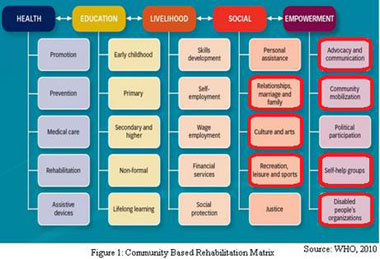The 3rd Asia-Pacific CBR Congress
Village Association of Disabled People, A platform supporting Community Based Inclusive Development (CBID) in China rural areas
Background:
Disability in China
Today, there are 85 million people with disabilities (6.8% of the population) in China1, 75% of them live in rural areas. They represent one of most vulnerable groups and face multiple barriers to access specific and mainstream services, and contribute to the society development. Removing these physical and, even more importantly, attitudinal barriers are vibrant to protect the rights of people with disabilities. In recent years, Chinese government has launched series of policies and programmes to improve the situation. Community Based Rehabilitation (CBR) is one of key strategies integrated in disability programme of Chinese government five year plans since the 90s. The centralized and top-down system is efficient in terms of resources integration and service development and makes important contribution to improve the living status of people with disabilities. Nevertheless, the gap is still large between polices and their implementation, especially in remote and rural areas. Support to and empowerment of people with disabilities to make change by their own initiatives is still weak. Making sure people with disabilities are at the center for decision making and action is indeed essential but not enough enforced.
China Disabled Persons’ Federation (CDPF) and the Village Association of Disabled People (“VAD”):
The China Disabled Persons’ Federation (CDPF) is semi-government organization addressing the needs of people with disabilities. CDPF is officially assigned three modalities for their mission: 1) represent the rights of people with disabilities; 2) provide services for people with disabilities; 3) coordinate and supervise the disability related affairs on behalf of government. The CDPF pyramid system is active from national to township level. VADs are official representations of DPF in rural communities. Defined by the CDPF policies, VAD is a grassroots organization of people with disabilities under the leadership of the village committee and the guidance of the township level DPF. VDA is supposed to bridge needs of people with disabilities and services or existing resources, through local mobilization and coordination. Nevertheless, many VADs today are often empty shell, because they lack capacity and strategy to fulfill their mission.
Handicap International (HI)- CDPF Community Based Rehabilitation and Social Inclusion Project in Yunnan.
HI and CDPF collaboratively pilot a Community Based Rehabilitation and Social Inclusion Project in two counties in Yunnan province since 2011. The project is implemented by the local Disabled Persons Federations of the two targeted counties, with a direct supervision from the Yunnan DPF. CDPF provides the overall administrative and coordination support. The role of Handicap International is to provide the necessary technical support and ensure the quality of the whole project.
The project particularly focuses on the last two components of the CBR matrix: empowerment and social. Project also links with other relevant components/elements to ensure access to relevant existing services for example (rehabilitation, assistive devices) and inclusion (education, vocational training, employment, etc).
Towards performing VDAs: lessons learned (Yunnan)
An organization structured to fulfil its mandate
Village Associations of Disabled People (VADs) were re-activated with a clear organization charter, a management committee, working policy and procedures, and now develop action plans, according to their mandate and the needs expressed by people with disabilities. VDAs 1) provide information to people with disabilities and their families for them to take informed decision and take responsibility for their development within the community; 2) create a platform for the members to discuss their common concerns, issues and to find together solutions. This is also an opportunity for people with disabilities to voice out their needs; 3) mobilize Disability Commissioners (“DCs”; DPF focal point person working at the village level) and community agents (village leaders, village doctors, women federation representatives, etc.) for needs of people with disabilities to be systematically assessed, reported and persons with disabilities to be referred to relevant stakeholders.
From integrated approach to inclusive approach:
By law VAD has to be under the direct management of village, and the village leader is assigned as the president of the association. Nevertheless, members with disabilities will be invited to take management responsibilities as well. VDA provides a good platform to facilitate the village leader understanding on disability issues, and integrate into the existing services responses to the needs of people with disability. Step by step, disability related needs become more visible and push the village/community to take into consideration and include people with disabilities in local program development.
VDA accountability increased through promotion of participation of people with disabilities
VDAs actors got familiar with the use of participative methods. By using these methods they support the development of VDAs key activities in consultation with people with disabilities themselves, and do not decide for them. Activities might be culture, leisure and sports related, leading to a more positive, friendly, respective relationship between people with disabilities and their families with other community members and groups. The current limit VDAs still need to address is the participation of all people with disabilities, especially those from most vulnerable groups.
Capacity building of key actors linked with VADs:
VADs play key role to ensure that key actors (disability commissioners, village leaders, women federation representative, SHG leaders, etc.) are connected and coordinating actions to be implemented. The project built capacities of these identified actors. Among them, the Disability Commissioner developed skills to accompany people with disabilities. The project trained them on disability, inclusion and CBR strategy, PSSA (Personalized Social Support Approach), communication and facilitation skills, awareness raising and advocacy etc. In two counties DCs meet regularly for case review, sharing good practices and lessons learnt. Their perception and attitudes towards disability changed, and they became the focal person for both people with disabilities and other stakeholders. They accompany people with disabilities soughing after changes. With other stakeholders, they reflect on identified needs and ways towards improved participation of people with disabilities.
From individual empowerment to group empowerment:
The PSSA is a very effective approach used by the DCs to accompany people with disability to identify their own needs and take responsibility for their development. People with disabilities are in the center of the action and get comprehensive support during the process. Their self-confidence increases while identifying by themselves and implementing their personal project. Besides individual supports, VDA offers the possibility for people with disability to gather into Self-help groups(SHGs), each group with its vision and purpose according to the group common interest or common development needs. SHGs, organize activities, share, learn and support each other. As a consequence people with disabilities get visible and respected in the communities through their increased participation to different social activities: art troop, traditional sport and recreation activities, vocational training courses, etc.
Case story: VAD in Wulong Village, Caiyun township, Shizong County
Wulong VAD was established in year 2000’s but not carrying any specific activity. In 2012, after assessment and mobilization activities supported by the project, Wulong formally re-activated its VADs. 119 people with disabilities (99M, 20F) joined the VAD as members. A management committee was elected by people with disabilities, and a person with disabilities designated as the vice-president of the association (president is the village leader). The key policy (the charter, the financial management rules) and Wulong VAD strategy were reviewed and approved by the management committee. And an action plan designed. According to the plan, the below key actions took place in Wulong to improve the participation and inclusion of people with disabilities:
- In 2013, the village committee provided an office for VDA for their regular activities and meeting
- In 2014/2015, a community rehabilitation service station was set up with support from the local government, the station is a place to provide community based rehab therapy for people with disabilities, for consultation, leisure and recreation activities, lease of necessary assistive devices...
- In 2014, thanks to the assessment and report from VAD, the percentage for people with disabilities covered by the minimum living assistance allowance increased from less than 30% to 90% of those who needs such support.
- 13 people with disabilities have complete their personal project and 10 more are working on it
- 2 persons with disabilities became Party and village committee members and participate to the decision making process of key issues of the village development
- 3 persons became member of the local village culture art troop
- Regular sports/art/recreation activities are organized with other groups: women, children, elderly;
- a series of awareness raising sessions organized at special festivals
- More than 100 referrals (period of time when it happened) to specialized and/or mainstream services (rehab, assistive devices, health, vocational training, education, livelihood etc) have been made possible.
1 China Disabled Persons’ Federation 2010
Slide 1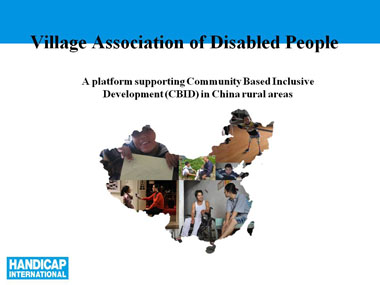 (Slide 1 text)
(Slide 1 text)
Slide 2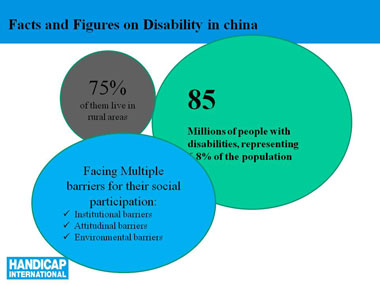 (Slide 2 text)
(Slide 2 text)
Slide 3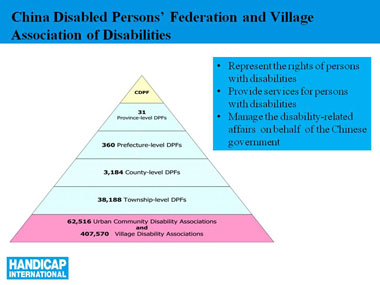 (Slide 3 text)
(Slide 3 text)
Slide 4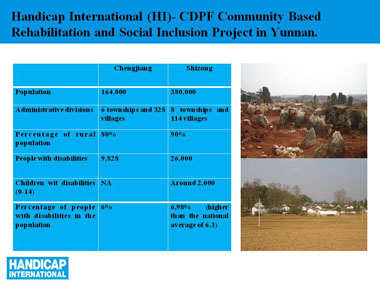 (Slide 4 text)
(Slide 4 text)
Slide 5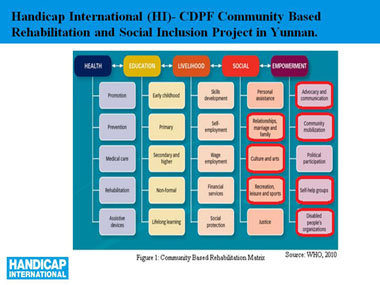 (Slide 5 text)
(Slide 5 text)
Slide 6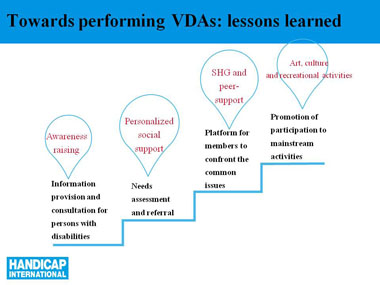 (Slide 6 text)
(Slide 6 text)
Slide 7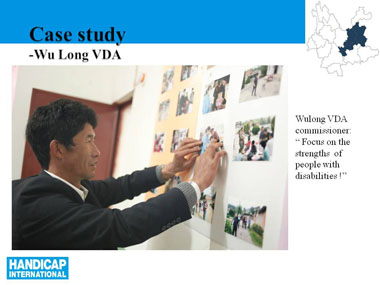 (Slide 7 text)
(Slide 7 text)
Slide 8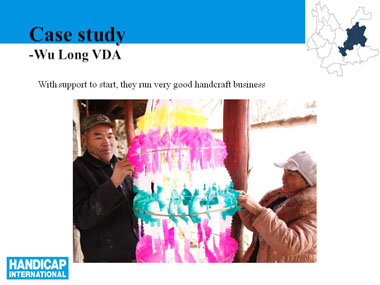 (Slide 8 text)
(Slide 8 text)
Slide 9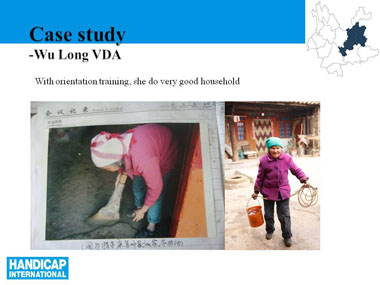 (Slide 9 text)
(Slide 9 text)
Slide 10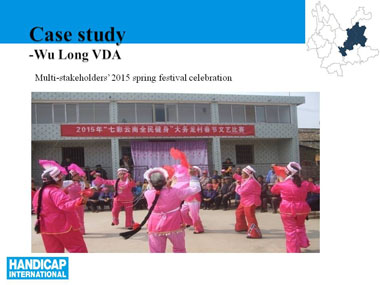 (Slide 10 text)
(Slide 10 text)
Slide 11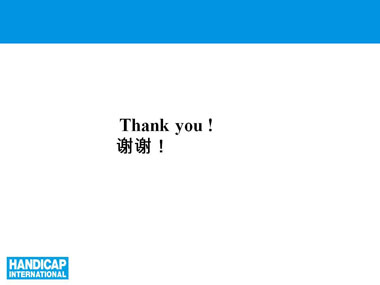 (Slide 11 text)
(Slide 11 text)

